Relief Intaglio-Type
For viscosity and relief printing .
ImagOn has great adhesive
qualities in addition to its photo sensitive qualities. Any of the Intaglio-Type techniques can
be either printed by the intaglio or relief printing method. It is
also possible to ink up a plate with the intaglio inking method and
relief roll ink directly on top of this previously intaglio inked
plate.
Materials:
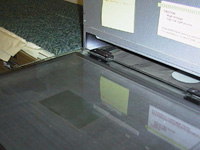
|
Recommended procedure:
Prepare Plate
Adhere ImagOn to plate
- see Basic
ImagOn Process Handout
- In
the case of the Relief Intaglio-Type the ImagOn film can be applied
to linoleum or plywood surface or any conventional wooden surface
used in wood block printing. If a wooden or linoleum surface is to
be used with the ImagOn film it is best to seal the wood with Future
liquid acrylic floor finish before applying the ImagOn film.
Although the ImagOn film will reluctantly stick to an unsealed
linoleum or wooden surface it is best to give these surface at least
one coat of the acrylic floor finish for better adhesion. In some
instances it is best to coat wooden relief plates with a number of
coats of the floor finish to control the amount of wood grain that
will appear in the finished print. If multiple coats of the acrylic
floor finish are applied to the plate make sure to sand smooth with
fine sandpaper between each layer.
- I see little point in using a wooden
plate if there is no visible sign of the wood grain in the finished
print but if there is too much grain this can also present an
aesthetic problem. It is for this reason that I recommend the liquid
acrylic floor finish coating procedure to add an element of control
within the finished print. At any stage of the image development the
wood block can easily be reworked with a Dremel tool or fine wire
brush. Not only do these reworking methods produce results akin to
wood block printing but this is a way to selectively enhance the
wood grain. Also when wood or linoleum is used the option remains to
cut into these surfaces with conventional wood cutting tools. This
can inject an image with deep embossed areas and lines. Inking these
plates in either the intaglio/relief technique can make further
image development or these plates can be inked solely as a relief
print.
|
|
|
Relief Intaglio-Type for Viscosity
Printmaking
- ImagOn is an ideal medium for those
printmakers who wish to work with viscosity printmaking techniques.
Because of the 2 mil thickness of the ImagOn film it can be
applied to a plate one layer on top of another for as many layers
that is deemed necessary to achieve the multilevel build-up that is
required of viscosity printing. The other creative advantage
for using ImagOn is the fact that it is so pliable that it can be
pre-cut to almost any shape before it is laminated to the plate. So
if one particular shaped area needs to be built up in higher relief
than the rest of the plate multiple layers of pre-cut ImagOn film
can be applied to that area of the plate. Once the first layer of
ImagOn has been laminated to the plate then all successive layers
can be applied with or without the water-alcohol spray. Some drier
studio conditions may necessitate the need for a higher
concentration of the alcohol-water spray while other studio
environments can dispense with using the laminating spray after the
first layer has been applied. Try to dry laminate ImagOn film after
the initial ImagOn layer has been applied. If the dry lamination
does not work then resort to using the alcohol/water lamination
spray. Remember to remove the top Mylar protection sheet from the
ImagOn film between layers.
- This multilayer relief building of
the ImagOn film on to the surface of the plate can either be done
hand in hand with image exposure and development between each layer
or without exposure and development between the layers. In the later
case the ImagOn film can be used for its thickness, shape making and
adhesion value. This method of using ImagOn simulates the way 3D
typographical maps are made.
- If you are exposing and developing
images to the ImagOn film and building up further images in this
manner make sure that your stencils have some density variations
between each layer. Otherwise there is little point in working a
multi-layered plate in this manner. If you are working with a series
of varying density images, whether it be hand drawn or photographic,
after the first layer of this image is exposed it is developed in
the soda ash solution, after which it is rinsed and thoroughly
dried. The second layer is then applied and the process repeated
until the image build up meets the desired levels required of
viscosity printing.
|
|
Olec Exposure Unit
|
Viscosity Image & Plate Making
- Processing an image for this type of
viscosity printmaking can be done by photocopying an image several
times on to photocopy Mylar and varying the contrast control
adjustment between each copy. In this way you can have an image with
varying contrast densities from the first image to the last. By
exposing the ImagOn film first to the photocopy that has the most
amount of photocopy toner and then to the successive less dense
images a viscosity plate can be made. If you are working in the
darkroom with conventional lith film processing then several density
variations of this image can be made from under-exposing to
over-exposing this image. This is sometimes referred to as
posterization of an image and is a favorite technique used in
screen-printing.
|
|
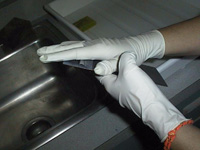
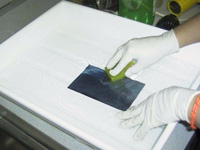
|
Printing the Relief Intaglio-Type
- After theRelief Intaglio-Type plate has been
made it must also be light hardened. One of the best relief
printing inks for relief prints is Graphic Chemical water-soluble
relief Ink. For the simplest relief ink prints apply layers of the
water-soluble ink and then print onto dry paper using the etching
press.
- When printing viscosity prints the
best inks to use are oil based litho or relief inks. The basic
principle of viscosity printing is to vary the viscosity and the
hardness of the relief printing rollers between each color and level
within the plate. Each color applied to the plate represents a
different hardness and viscosity of ink. The complexity of this
printmaking technique is such that the uninitiated printmaker will
have to seek further information through books that deal more
thoroughly with this technique. See the bibliography listed at the
back.
|
|
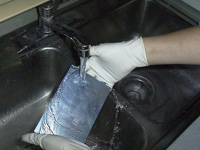
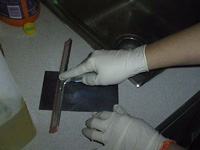
|
Reworking the Relief Intaglio-Type
Plate
- If the ImagOn film has been built up
in to high relief portions of the plate can be sanded with various
types of sandpaper from coarse to rough depending on the desired
results.
- ImagOn areas can be selectively
painted with a 20% caustic soda solution, while taking the proper
safety precautions of wearing rubber gloves and eye protection, to
remove the ImagOn emulsion. The strength of the caustic soda
solution can be varied for either more control or quicker biting
action.
- All kinds of Dremel tool bits can
also be used to grind and manipulate the surface of the ImagOn
emulsion. If a dust is created during this procedure it is also
advisable to use a dust mask to avoid breathing in these polymer
particles.
- The reworking instructions outline
under the Intaglio-Type technique can also be applied for the Relief
Intaglio-Type
- After a copper plate has been
laminated with ImagOn it can be exposed, developed and then etched
in a ferric chloride solution. In this way a photo or hand drawn
relief image can be made. This presents a more conventional way of
working with an etched plate because at any stage of the etching
process the plate can be stopped out with acrylic floor finish to
create the various levels needed with a viscosity plate. When using
Future for stopping out the plate it is best to apply one layer then
wait for it to dry and follow up by giving it another layer.
Two thin layers work better than one thick layer.
- If a plate has been etched it is
advisable to clean those etched areas with a deoxidizing solution
before the blocking-out procedure.
Deoxidizing solution; A deoxidizing
solution can be made with white vinegar and table salt. Add 8
tablespoons of salt to one cup of white vinegar. After cleaning the
raw copper plate with the deoxidizing solution wait until it dries
before stopping-out.
- When working with relief printmaking
images these images are composed in the negative form because the
areas of the relief plate that are removed represents the colour of
the paper. There exists an opportunity to reverse this negative
reading quality with the Relief Intaglio-Type because at any time during the
etching sequence the unprotected areas of the copper plate can be
aquatinted(if necessary). The best aquatint to use is the Hunt
Speedball Water Soluble Screen Filler 4570. Spray the diluted screen filler onto the plate with a Paache
Airbrush Model-H.
- If screen filler has been used for the
aquatint it is best to remove it with Fantastic or Mr. Clean before
printing the plate. This screen filler can also be removed can by
sanding the relief surface of the plate with 320 to 600 grit
wet-and-dry sand paper with a finishing sander. The plate should be
completely dry before sanding and the wet-and-dry sandpaper should be
used dry. A flat piece of wood wrapped in sandpaper can be used for
this sanding procedure. If an electric finishing sander is used,
with the 600 grit sandpaper, a glass like finish on the relief surface
results.
|
|
|
Print Plate
Printing the Etched Intaglio-Type plate
After the plate has etched it can be printed with the ImagOn emulsion
still intact on the plate. This makes the plate easier to wipe and may
preserve some minute details that did not etch. It is advisable to proof
the plate first with the ImagOn emulsion on the plate and then with this
emulsion removed. Comparing both results will enable you to determine
exactly which areas of the plate did actually etch. The ImagOn emulsion
is removed in the same manner described under the Basic ImagOn Process
Handout. It should also be noted that further image
manipulation can occur if the ImagOn emulsion is selectively removed
from the plate. Sanding with 600-grit sandpaper can most easily control
this. Where the ImagOn emulsion is retained on the plate there will be
no plate tone and where the ImagOn is removed there will be plate
tone.
- see Printing Handout
|
|
|
Rubylith Stencils for the Relief
Etch-Intaglio-Type
- Simple plates can be made by making
stencils from Rubylith type masking films (which are used extensively
in screen printing). These masking films are ideal for those
printmakers who are comfortable working with hand-cut stencils and
multiple stencil overlays. All stencils can be pre-cut and colour
choices made before plate making. There are two approaches that can be
made for plate making and for printing. Either a etch or non-etch
plate can be made and these plates can be printed in either relief or
intaglio.
- Other stencil material can also be
used for the Relief Intaglio-Type. Any low relief object from plant material to
the most delicate lace can be placed in contact to the ImagOn film and
exposed to the UV exposure light, developed, dried and light-hardened.
Some intricate stencils such as loose weave fabrics and fine lace can
be printed intaglio or relief immediately after the plate is made. The
choice also exists to either etch or not etch these plates.
Other plates may necessitate the application of an aquatint with the
Hunt Speedball screen filler method described above.
- Another way of working with the
non-etch method is to apply a layer of ImagOn and then expose that
layer to the aquatint screen after which another layer of ImagOn is
applied to the plate and then exposed to the stencil.
|
Develop
 .
.  .
.  .
. 
Print





